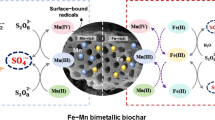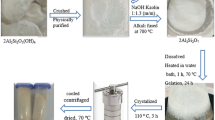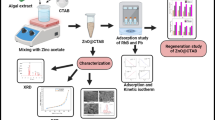Abstract
Iron-loaded mangosteen shell powder (Fe-MSP) was found as an effective heterogeneous Fenton catalyst for the treatment of stabilized landfill leachate. Sonolytically produced catalyst has higher efficiency than other catalysts. At the optimal conditions (pH 3, catalyst concentration of 1,750 mg/L and hydrogen peroxide concentration of 0.26 M), 81 % of the chemical oxygen demand (COD) was removed effectively from the landfill leachate. But, the efficiency of Fe-MSP was reduced in the first recycling due to the poisoning of active sites. A metal leaching study indicated that the degradation of the pollutant is mainly due to solid Fe ions present in Fe-MSP rather than the leached ferrous and ferric ions. Hydroxyl radical production in the system was confirmed by the Fenton oxidation of benzoic acid. Compared to the homogeneous Fenton process, the heterogeneous Fenton process using Fe-MSP had higher COD removal efficiency, indicating the practical applicability of the prepared catalyst.











Similar content being viewed by others
References
Absalan G, Asadi M, Kamran S, Sheikhian L, Goltz DM (2011) Removal of reactive red-120 and 4-(2-pyridylazo) resorcinol from aqueous samples by Fe3O4 magnetic nanoparticles using ionic liquid as modifier. J Hazard Mater 192:476–484
Ahmad MA, Alrozi R (2010) Optimization of preparation conditions for mangosteen peel-based activated carbons for the removal of Remazol Brilliant Blue R using response surface methodology. Chem Eng J 165:883–890
APHA (1998) Standard methods for the examination of water and wastewater, 17th edn. American Public Health Association, Washington, DC
Brillas E, Sires I, Oturan MA (2009) Electro-Fenton process and related electrochemical technologies based on Fenton’s reaction chemistry. Chem Rev 109:6570–6631
Daud NK, Hameed BH (2010) Decolorization of Acid Red 1 by Fenton-like process using rice husk ash-based catalyst. J Hazard Mater 176:938–944
Dükkancı M, Gündüz G, Yılmaz S, Prihodko RV (2010) Heterogeneous Fenton-like degradation of Rhodamine 6G in water using CuFeZSM-5 zeolite catalyst prepared by hydrothermal synthesis. J Hazard Mater 181:343–350
Foo KY, Hameed BH (2012) Factors affecting the carbon yield and adsorption capability of the mangosteen peel activated carbon prepared by microwave assisted K2CO3 activation. Chem Eng J 180:66–74
Gan PP, Li SFY (2013) Efficient removal of Rhodamine B using a rice hull-based silica supported iron catalyst by Fenton-like process. Chem Eng J 229:351–363
George SJ, Gandhimathi R, Nidheesh PV, Ramesh ST (2013) Electro-Fenton method oxidation of salicylic acid in aqueous solution with graphite electrodes. Environ Eng Sci 30:750–756
Gupta VK, Rastogi A (2008) Biosorption of lead (II) from aqueous solutions by non-living algal biomass Oedogonium sp and Nostoc sp: a comparative study. Colloid Surf B: Biointerfaces 64:170–178
Hassan H, Hameed BH (2011) Fenton-like oxidation of Acid Red 1 solutions using heterogeneous catalyst based on ball clay. Int J Environ Sci Tecnol 2:218–222
Idel-aouad R, Valiente M, Yaacoubi A, Tanouti B, López-Mesas M (2011) Rapid decolourization and mineralization of the azo dye CI Acid Red 14 by heterogeneous Fenton reaction. J Hazard Mater 186:745–750
Kumar S, Rai SB (2010) Spectroscopic studies of L-arginine molecule. Ind J Pure Appl Phys 48:251–255
Liao Q, Sun J, Gao L (2009) Degradation of phenol by heterogeneous Fenton reaction using multi-walled carbon nanotube supported Fe2O3 catalysts. Colloids Surf, A 345:95–100
Martınez SS, Sanchez JV, Estrada JRM, Velasquez RF (2011) FeIII supported on ceria as effective catalyst for the heterogeneous photo-oxidation of basic orange 2 in aqueous solution with sunlight. Solar Energy Mater Solar Cells 95:2010–2017
Misra A, Tyagi PK, Singh MK, Misra DS (2006) FTIR studies of nitrogen doped carbon nanotubes. Diam Relat Mater 15:385–388
Navalon S, Alvaro M, Garcia H (2010) Heterogeneous Fenton catalysts based on clays, silicas and zeolites. Appl Catal B: Environ 99:1–26
Neyens E, Baeyens J (2003) A review of classic Fenton’s peroxidation as an advanced oxidation technique. J Hazard Mater B98:33–50
Nidheesh PV, Gandhimathi R (2012) Trends in electro-Fenton process for water and wastewater treatment: an overview. Desalination 299:1–15
Nidheesh PV, Gandhimathi R, Ramesh ST (2013) Degradation of dyes from aqueous solution by Fenton processes: a review. Environ Sci Pollut Res 20:2099–2132
Nidheesh PV, Gandhimathi R, Velmathi S, Sanjini NS (2014) Magnetite as a heterogeneous electro Fenton catalyst for the removal of Rhodamine B from aqueous solution. RSC Adv 4:5698–5708
Okonogi S, Duangrat C, Anuchpreeda S, Tachakittirungrod S, Chowwanapoonpohn S (2007) Comparison of antioxidant capacities and cytotoxicities of certain fruit peels. Food Chem 103:839–846
Oturan MA, Oturan N, Edelahi MC, Podvorica FI, El Kacemi K (2011) Oxidative degradation of herbicide diuron in aqueous medium by Fenton’s reaction based advanced oxidation processes. Chem Eng J 171:127–135
Pignatello JJ, Oliveros E, Mackay A (2006) Advanced oxidation processes for organic contaminant destruction based on the Fenton reaction and related chemistry. Crit Rev Environ Sci Technol 36:1–84
Ramesh ST, Gandhimathi R, Badabhagni N, Nidheesh PV (2011) Removal of Cd (II) from aqueous solution by adsorption onto coir pith, an agricultural solid waste: batch experimental study. Environ Eng Manage J 10:1667–1673
Renou S, Givaudan JG, Poulain S, Dirassouyan F, Moulin P (2008) Landfill leachate treatment: review and opportunity. J Hazard Mater 150:468–493
Rodriguez A, Ovejero G, Sotelo JL, Mestanza M, Garcıa J (2010) Heterogeneous Fenton catalyst supports screening for mono azo dye degradation in contaminated wastewaters. Ind Eng Chem Res 49:498–505
Shukla P, Wang S, Sun H, Ang H-M, Tadé M (2010) Adsorption and heterogeneous advanced oxidation of phenolic contaminants using Fe loaded mesoporous SBA-15 and H2O2. Chem Eng J 164:255–260
Singla R, Ashokkumar M, Grieser F (2004) The mechanism of the sonochemical degradation of benzoic acid in aqueous solutions. Res Chem Intermed 30:723–733
Sun H, Zhou G, Liu S, Ang HM, Tade MO, Wang S (2012) Nano-Fe0 encapsulated in microcarbon spheres: synthesis, characterization, and environmental applications. ACS Appl Mater Interfaces 4:6235–6241
Wang SL, Wang Q, Fang YF, Huang YP (2013) Degradation of organic pollutants by visible light synergistic electro-Fenton oxidation process. Sci China Chem doi: 101007/s11426-012-4809-1
Winuprasith T, Suphantharika M (2013) Microfibrillated cellulose from mangosteen (Garcinia mangostana L) rind: preparation, characterization, and evaluation as an emulsion stabilizer. Food Hydrocolloids 32:383–394
Xavier S, Gandhimathi R, Nidheesh PV, Ramesh ST (2013) Comparison of homogeneous and heterogeneous Fenton processes for the removal of reactive dye magenta MB from aqueous solution. Desalination Water Treat doi: 101080/194439942013844083
Yao P (2013) Perspectives on technology for landfill leachate treatment. Arab J Chem. doi:10.1016/j.arabjc.2013.09.031
Author information
Authors and Affiliations
Corresponding author
Additional information
Responsible editor: Philippe Garrigues
Highlights
• Iron-loaded mangosteen shell powder as heterogeneous Fenton catalyst.
• Pollutant degradation on catalyst surface Fenton reactions.
• 81 % of the COD from the leachate was removed.
• Higher efficiency than that of homogeneous Fenton process.
Novelty statement
The present study deals with the removal of COD from landfill leachate using iron-loaded mangosteen shell powder as heterogeneous Fenton catalyst. The effect of various factors on the Fenton process was studied. The metal leaching study showed that the oxidation of pollutants occurred on the surface of the catalyst. Hydroxyl radical production in the system was confirmed by the Fenton oxidation of benzoic acid. Compared with the homogeneous Fenton process, the heterogeneous Fenton process had higher COD removal efficiency.
Rights and permissions
About this article
Cite this article
Laiju, A.R., Sivasankar, T. & Nidheesh, P.V. Iron-loaded mangosteen as a heterogeneous Fenton catalyst for the treatment of landfill leachate. Environ Sci Pollut Res 21, 10900–10907 (2014). https://doi.org/10.1007/s11356-014-2883-y
Received:
Accepted:
Published:
Issue Date:
DOI: https://doi.org/10.1007/s11356-014-2883-y




